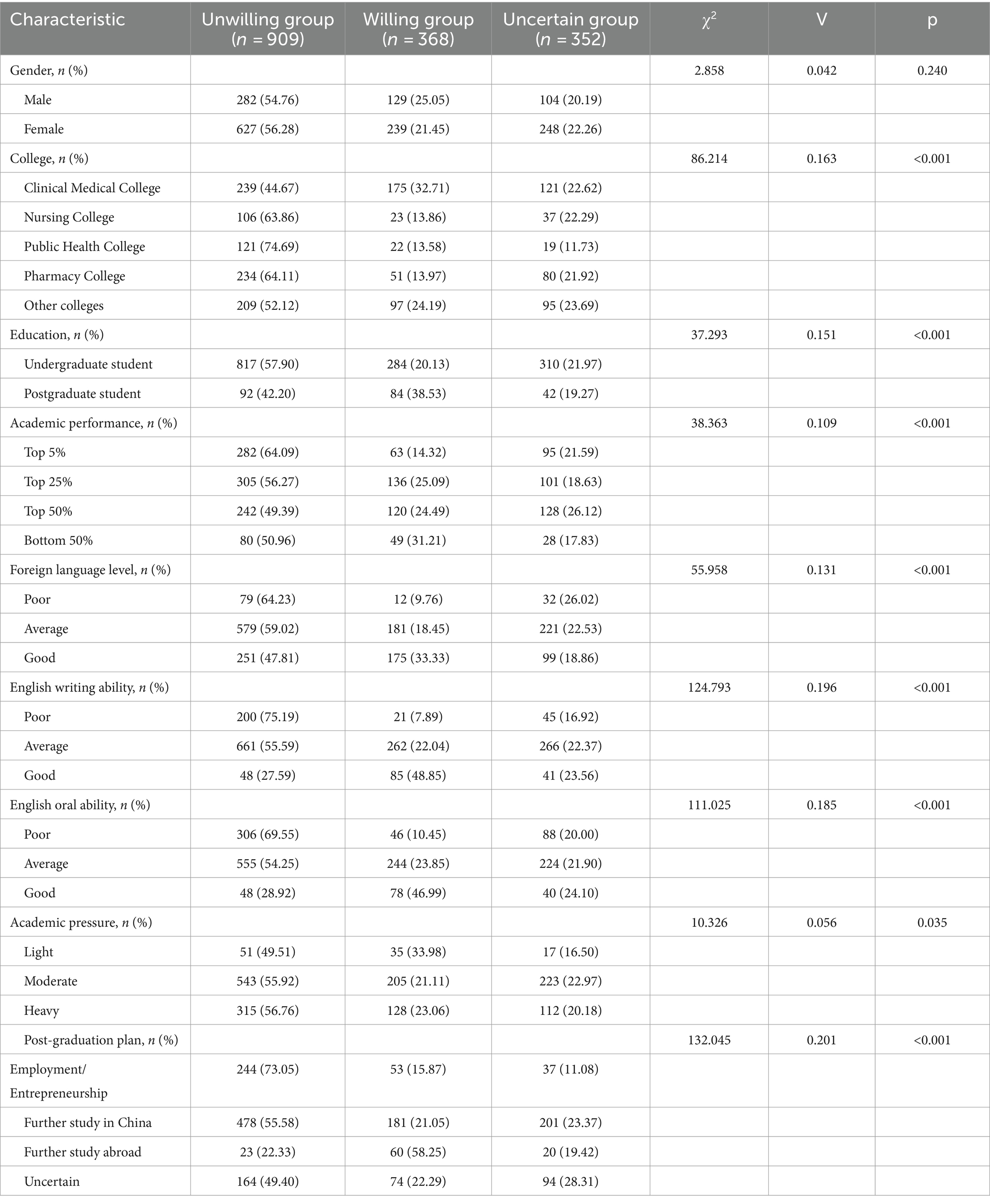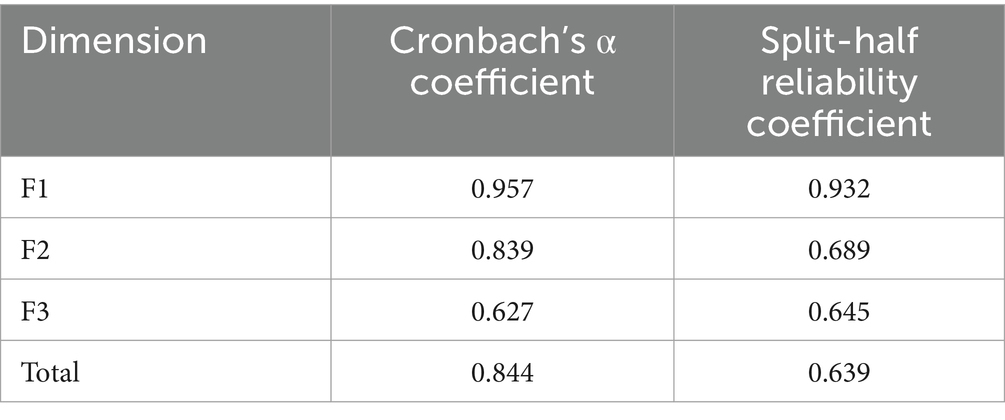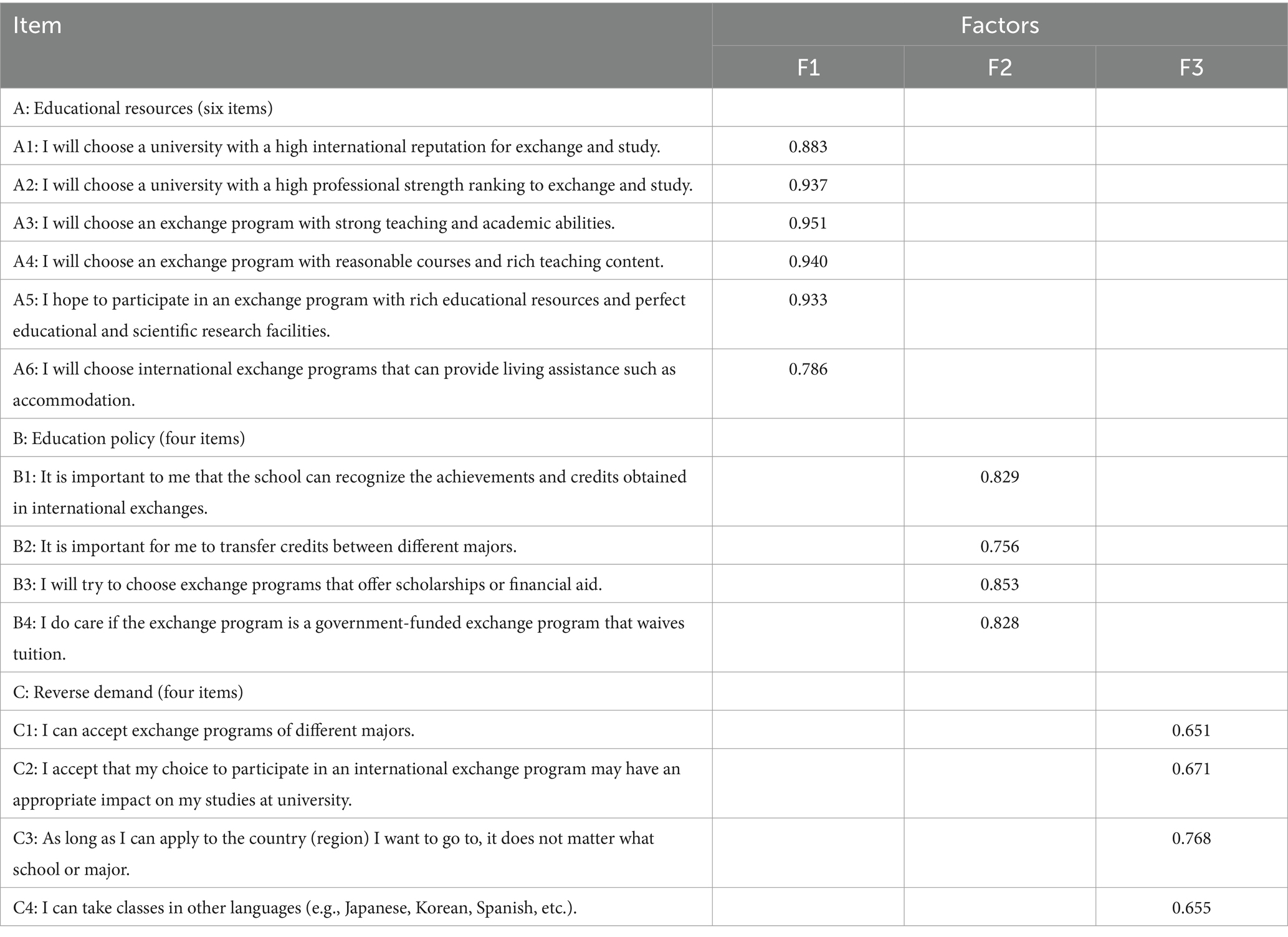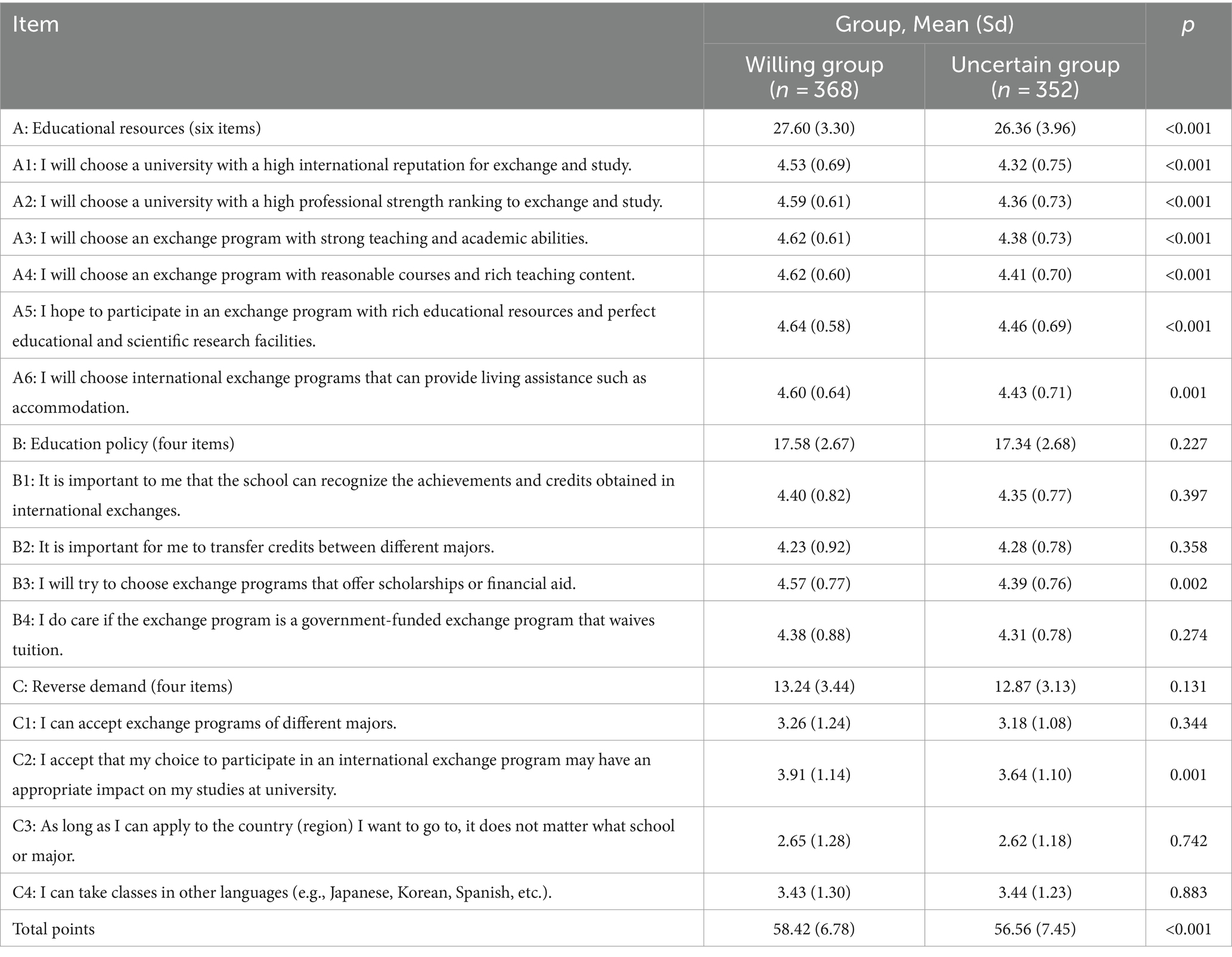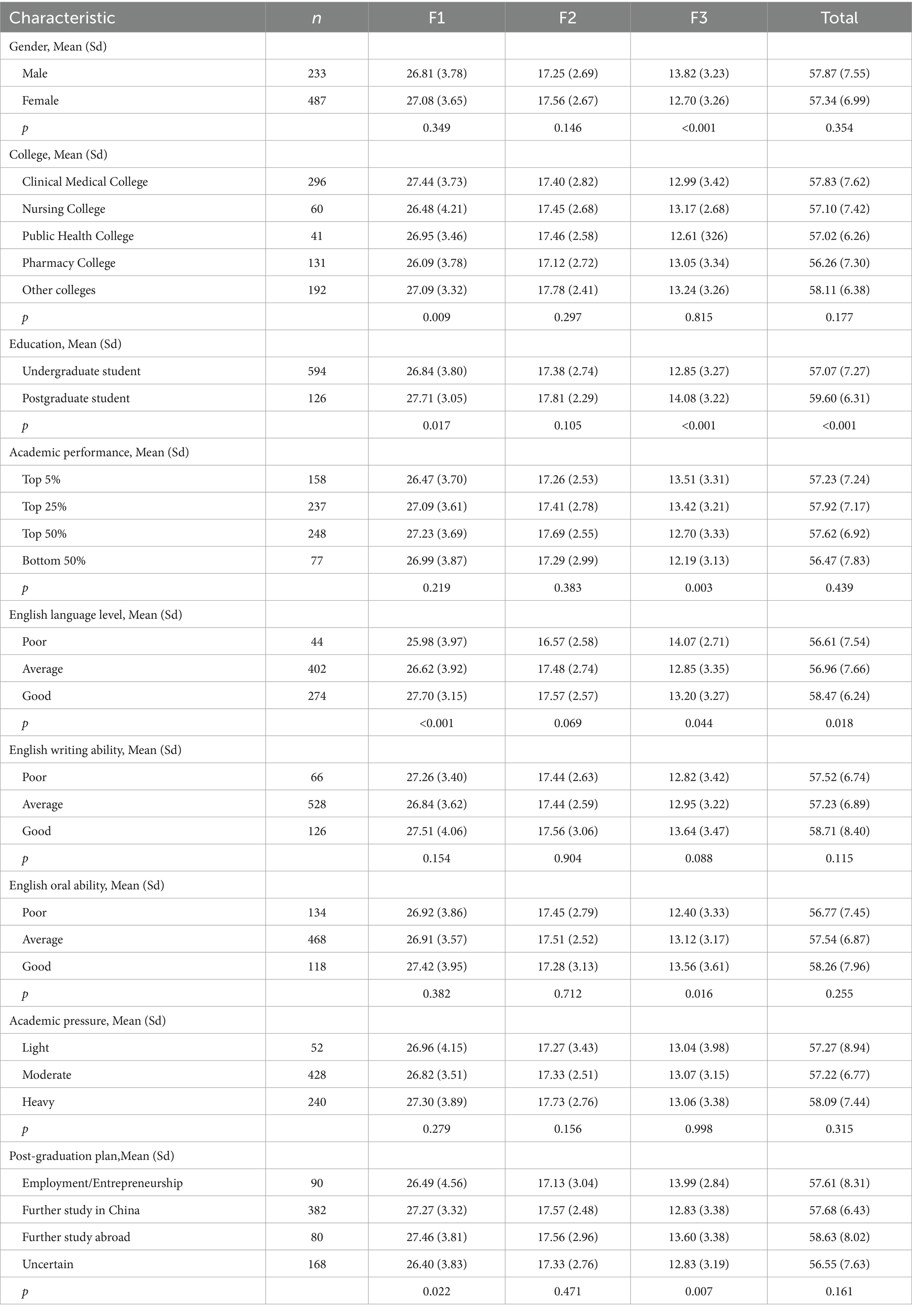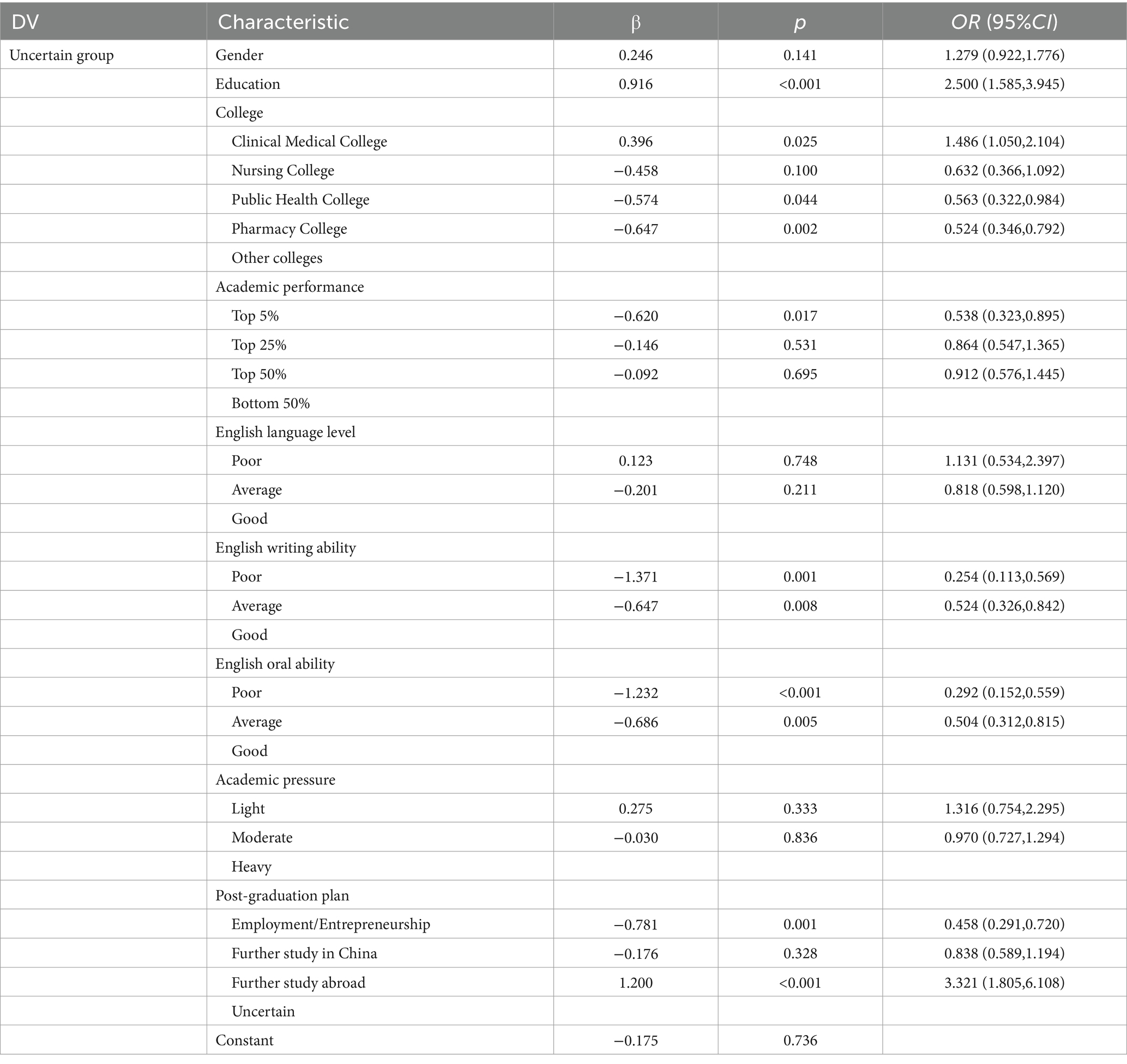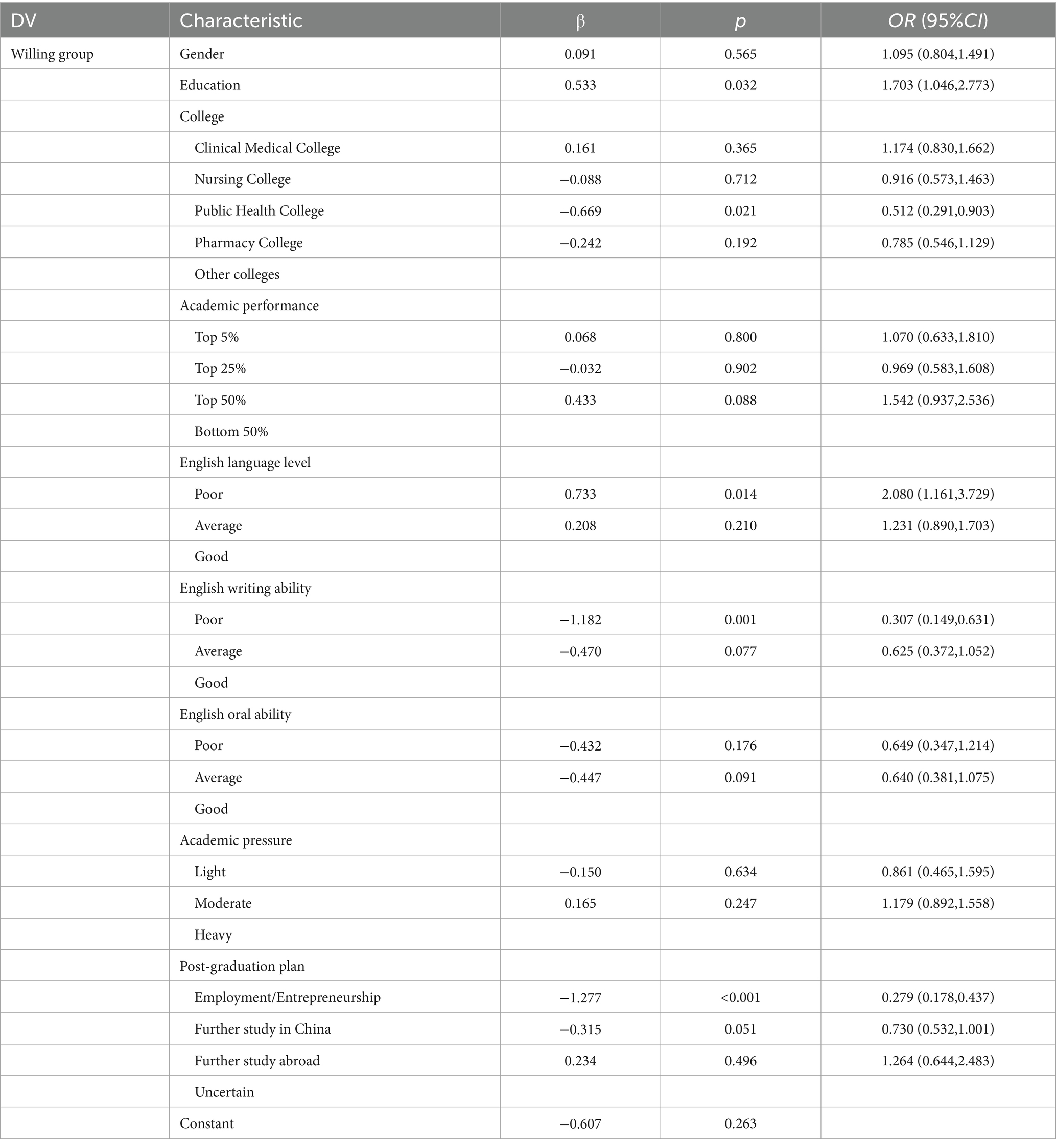- 1School of Public Health, Zhejiang Chinese Medical University, Hangzhou, China
- 2International Relations Office, Zhejiang Chinese Medical University, Hangzhou, China
Objective: There has been a significant increase in international student exchange in recent years, with medical students comprising a large proportion of international students. This study aimed to develop and validate a questionnaire, the Medical Student Overseas Exchange Willingness and Demand Survey Questionnaire (MS-OEWDSQ), to assess medical students’ intentions to study abroad and explore the potential influencing factors.
Methods: This study was conducted in three stages: item generation and scale development; pilot study; and examination of scale reliability and validity. The item pool for the questionnaire was compiled from a literature review, an assessment of other relevant questionnaires, and interviews with medical students. Descriptive statistics were generated, and correlation analysis was performed to analyze the questionnaire data. The reliability of the measure was examined according to its internal consistency and split-half reliability. Exploratory factor analysis (EFA) and confirmatory factor analysis (CFA) were used to determine the factor structure and test the construct validity.
Results: The final version of the MS-OEWDSQ comprised three factors with a total of 14 items. The total Cronbach’s α coefficient of the questionnaire was 0.844, and the total split-half reliability coefficient was 0.639. This study also identified several factors that may affect medical students’ willingness to go abroad for exchange. Specifically, education (p < 0.05) and foreign language level (p < 0.05) were associated with the MS-OEWDSQ score, providing directions for future related research.
Conclusion: This study developed and validated a questionnaire to measure medical students’ willingness and demand for overseas exchange. This measure provides a powerful tool for evaluating whether medical students are willing to participate in overseas exchange. The questionnaire can be employed to help medical students self-test their intention to study abroad and to help medical colleges provide more accurate support and assistance to students who intend to study abroad.
1 Introduction
Today, the internationalization of education has become a key driving force in higher education on a global scale (Hvalič-Touzery et al., 2017). Among the many characteristics of the internationalization of higher education, international student mobility (ISM) is one of the most important manifestations and has become a prominent feature of all higher education (HE) policies (Shields, 2016). According to the United Nations Educational, Scientific and Cultural Organization (UNESCO, 2022), since the beginning of the 21st century, global ISM has increased from 2.27 million in 2001 to 6.36 million in 2020 (UNESCO, 2022). Asia-Pacific countries, particularly China, are the primary source of international students worldwide. The benefits of participating in international student exchange are well known. Students who study abroad play an important role in bringing the academic, cultural and economic benefits of their study destination back home; they are also important ambassadors for their study destination to communicate with their home country. Schools and governments continue to work to increase the number of students who study abroad (Button et al., 2005).
As a result of increased international mobility due to travel, immigration, and other reasons, doctors increasingly need to master cross-cultural skills to deal with diverse patients (Houpt et al., 2007). Overseas study experience is also increasingly valued by hospitals and policymakers. As a result, medical students are increasingly interested in overseas exchange and study opportunities during university (Brown et al., 2016). An international study experience can provide medical students with the opportunity to learn about different people and cultures (Meaux et al., 2021). Research shows that short-term study abroad can effectively develop students’ cultural knowledge and cross-professional ability, expand students’ global perspective, and even improve their employment prospects in their home country after graduation (Manspeaker et al., 2019; Gartmeier et al., 2020). By immersing themselves in international study experiences, medical students can acquire the necessary skills and knowledge to navigate the complexities of a multicultural healthcare landscape, ultimately benefiting both patients and the healthcare system as a whole.
The drivers of the decision to study abroad include personal characteristics, such as gender and personality. Students’ sense of agency and self-efficacy, socioeconomic level, language ability, and communication skills also influence their choice to engage in international mobility (Petrovich, 2004; Brown et al., 2016; López-Duarte et al., 2021). For example, students from English-speaking countries often prefer to participate in overseas exchange in other English-speaking countries, while other groups of students tend to seek exchange opportunities in countries where the language is easier to learn (Goldbart et al., 2005; Goodman et al., 2008). Researchers have proposed a variety of explanatory models for assessing students’ international exchange needs. Econometric models, for example, emphasize that students make decisions based on their judgments about the costs and benefits of overseas exchange (Smart, 2008). The sociological model holds that students’ needs are affected by factors such as socioeconomic status and individual academic ability. By employing these models, researchers aim to gain deeper insights into the underlying factors driving students’ aspirations for studying abroad, enabling institutions and policymakers to tailor programs and support services to meet the unique needs of diverse student populations. In the available literature on the motivations underlying ISM, the push-pull theory is the most commonly cited model (Lee, 1966; Yue and Lu, 2022). One study based on the push-pull theory identified various push factors (domestic competition pressure) and pull factors (employment advantages after graduation or high-quality teaching experiences in host countries) that could explain the reasons for students studying abroad (Altbach, 2004).
Although the push-pull theory is a commonly employed framework in the field of ISM, the analysis of student mobility should not be limited to one framework (Findlay et al., 2012). Importantly, the push-pull model focuses too much on macro or external factors and too little on micro or individual factors that affect overseas exchange learning. This limits its application prospects. Moreover, many studies by foreign scholars have focused on developed countries; few studies have examined the decision-making of students from developing countries in relation to studying abroad, and targeted research evaluation of medical students is also rare (Kelleher et al., 2016). To increase students’ motivation to participate in study-abroad programs, it is crucial to understand what motivates or prevents them from doing so. The main purpose of this study was to develop a special questionnaire to measure medical students’ overseas exchange willingness and needs. The ultimate goal was to better understand and evaluate the overseas exchange willingness and needs of medical students. This would enable the provision of more accurate information and targeted exchange opportunities and support services to meet the specific needs of medical students, thereby facilitating their international educational journeys.
2 Methods
Based on the questionnaire preparation procedure summarized by Boateng et al. (2018), Zhejiang Chinese Medical University Institutional Review Boards approved the study (No: 20230130-2). The questionnaire was prepared according to the following three stages.
2.1 Phase 1: item generation and scale development
In phase 1, a comprehensive literature review was conducted to assess existing published questionnaires and studies, aiming to understand the structures and dimensional designs of these questionnaires (Lee and Tan, 1984; Brown et al., 2016; Gunn et al., 2020; Yue and Lu, 2022). The development of the questionnaire was based on published research literature on overseas exchange intentions and in-depth interviews with a number of medical students. The interview topics included general information, overseas exchange intentions, personal concerns, etc. (Kelleher et al., 2016; Alser et al., 2021; Li et al., 2022). Ultimately, six dimensions were identified and a preliminary questionnaire consisting of 28 items for undergraduate students and 26 items for postgraduate students was developed. Each item in the preliminary questionnaire was measured on a five-point Likert scale, where 1–5 represented “strongly agree,” “agree,” “uncertain,” “disagree,” and “strongly disagree,” respectively.
2.2 Phase 2: pilot study
A pilot study was conducted with a random sample of 10 students from Zhejiang Chinese Medical University, five of whom were undergraduate students, and the remaining five were postgraduate students. The students completed the preliminary questionnaire and were asked to provide comments and feedback on the questionnaire, including whether the content was clear and easy to understand and whether the items were set up properly. Following this step, the reliability and validity of the questionnaire were rigorously tested to ensure its suitability for the intended study.
2.3 Phase 3: test of the validity and reliability
The questionnaire was administered to medical students at Zhejiang Chinese Medical University. The online questionnaire survey tool “SoJump” was used to generate the questionnaire and the link to the questionnaire was posted in the WeChat groups of each college. All questionnaire responses were anonymous. To ensure the quality of the data and the validity of the statistical results, questionnaires with a missing item rate exceeding 20% or those with clearly unreliable responses were deemed invalid and were excluded from analysis (for example, questionnaires containing highly repetitive choices or answers that were logically confusing or inconsistent). The questionnaire was distributed to 1,629 students, and 1,653 students (98.55%) provided valid responses. Then, factor analysis and validity testing were performed on the data. The reliability (Cronbach’s α coefficient, split-half reliability) and validity (structure validity, content validity) of the questionnaire were tested. Exploratory factor analysis (EFA) was first used to discover the underlying construct and dimensions as well as to examine the relationships of observed indicators and factors. According to the results of statistical analysis, the Kaiser-Meyer-Olkin (KMO) value was greater than 0.7 and the p value of Bartlett’s sphericity test was less than 0.05. The KMO statistic is used to measure the proportion of the common variance (potentially caused by the common factor) that is shared by all items. It ranges from 0 to 1, with a KMO value closer to 1 indicating a stronger correlation among variables, making them more suitable for factor analysis. And the Bartlett’s sphericity test is used to assess if the correlation matrix is an identity matrix, that is, to test whether the variables are independent. The non-significance results show that the correlation matrix based on the sample data is not the identity matrix, implying the presence of correlations between the original variables, and it is suitable for factor analysis. Therefore, the results indicated that the questionnaire was suitable for EFA. Thus, principal component analysis (PCA) was used to extract the factors; the Varimax rotation was used as the factor rotation method. Items with factor loadings <0.50 on all factors or items that were loaded on two or more factors were deleted. After determining the factor structure of the questionnaire scale, confirmatory factor analysis (CFA) was used to verify the correctness of the structure.
2.4 Data analysis
The data analysis was conducted using SPSS 26.0 software. Descriptive statistics were generated to summarize the demographic characteristics of the study sample. Internal consistency reliability was evaluated using Cronbach’s α coefficient. Construct validity was examined through EFA and CFA. Correlation analysis was performed among the items, and correlation coefficients were calculated using either Pearson or Spearman correlation analysis to assess the suitability of the data for factor analysis. The independent T-test was used to compare the factor scores of different groups. Multinomial logistic regression was used to analyze the influencing factors of overseas exchange learning intention, and the OR value and 95%CI were calculated.
3 Results
3.1 The results of the pilot study
The preliminary questionnaire was completed by the participants within 15 min, and no feedback or suggestions were provided regarding the items. The questionnaire was considered to be of moderate length and was easy to complete. All items were deemed relevant to the study’s purpose, and no exclusions or additions were made. Certain ambiguous items in the questionnaire were revised to avoid any potential misunderstandings.
3.2 Participant characteristics
Among the 1,629 participants who completed valid questionnaires, 515 (31.61%) were male and 1,114 (68.39%) were female. The School of Clinical Medicine, the School of Pharmacy, and the School of Public Health accounted for a relatively large number of students; 32.84, 22.41 and 9.94%, respectively (Table 1). The Chi-Square test was used to analyze the characteristics of the willing group, the unwilling group and the uncertain group, and Cramer’s V correlation analysis was performed. There were statistically significant differences among the groups in terms of college (p < 0.05), education (p < 0.05), academic performance (p < 0.05), foreign language level (p < 0.05), English writing ability (p < 0.05), oral ability (p < 0.05), and post-graduation plan (p < 0.05), and there was a correlation between the above factors and the medical students’ willingness to study abroad.
3.3 The reliability results
The Cronbach’s α coefficient and split-half reliability coefficient reflect the internal consistency of the questionnaire (Table 2). Generally speaking, a Cronbach’α coefficient between 0.65and 0.70 is the minimum acceptable value, 0.70 and 0.80 is rather good, and 0.80 and 0.90 is the best. The results showed that the Cronbach’α coefficient of the questionnaire was 0.844, and the reliability test results of the three dimensions were as follows: Cronbach’s α coefficient of F1 = 0.957 > 0.6, Cronbach’s α coefficient of F2 = 0.839 > 0.6, Cronbach ‘α coefficient of F3 = 0.627 > 0.6. This indicates that the reliability of the overall scale is good. The split-half reliability coefficient of the scale was 0.639, and the values of each dimension ranged from 0.645 to 0.932. Together, these results indicate that the MS-OEWDSQ has good internal consistency and reliability.
3.4 The validity results
3.4.1 Construct validity
Exploratory factor analysis and CFA were used to investigate the construct validity of MS-OEDSQ.
The KMO measure of sampling adequacy (KMO value > 0.7) and the result of Bartlett’s test of sphericity (p < 0.001) indicated that the questionnaire was suitable for exploratory factor analysis. Principal component analysis with varimax orthogonal rotation was used to determine the underlying factor structure of the questionnaire. Three meaningful factors with eigenvalues greater than 1 were extracted. Then, items with factor loadings <0.50 on all factors or items that loaded on two or more factors were deleted. Ultimately, 14 items were retained in the final questionnaire. The loadings of each factor ranged from 0.651 to 0.951 (Table 3). The six items included in F1 (Educational Resources) reflect the importance and attention medical students pay to educational resources when choosing overseas exchange study programs. The four items included in F2 (Education Policy) are directly related to the provisions and educational policy support, and the four items included in F3 (Reverse needs considerations) reflect the consideration of flexibility and the inclusion of individual academic interests and personal orientations of medical students when choosing an exchange study program. The results of the scree plot verified the extraction of these three factors (Figure 1).
Confirmatory factor analysis was performed based on the factor structure and items extracted through the EFA. Structural equation modeling (SEM) was conducted using the maximum likelihood estimation method. The model goodness-of-fit was assessed using the standardized root mean square residual (SRMR), comparative fit index (CFI), and Tucker–Lewis fit index (TLI). Satisfactory fitting indices were obtained in the CFA (CFI > 0.90, TLI > 0.90, SRMR<0.05; Table 4).
3.4.2 Content validity
Content validity is an important measure of scale quality. Six experts participated in the content validity evaluation, and the experts’ majors included education management, international communication, statistics, and student management. Some contents of the questionnaire were revised according to the expert’s evaluation of the questionnaire item design. It can be seen from the correlation analysis (Table 5) that the r values of F1 ranged from 0.823 to 0.946, those of F2 ranged from 0.786 to 0.847, and those of F3 ranged from 0.653 to 0.738, reflecting high correlations. This indicates that the questionnaire items are accurate and comprehensive, covering the factors affecting the overseas exchange demands of medical students. The content validity of the scale was supported.
3.5 MS-OEWDSQ analysis
Based on their responses, the participants were divided into three groups according to their intentions to participate in international exchange: a willing group, an unwilling group, and an uncertain group. Comparisons were made between the questionnaire scores of the willing group and the uncertain group. In Table 6, it can be seen that there were statistically significant differences (p < 0.001) between the two groups across various dimensions related to educational resources. In terms of educational policies, there was a statistically significant difference (p < 0.005) between the two groups for item B3: “I will try to choose exchange programs that offer scholarships or financial aid.” Additionally, regarding reverse demand, there was a statistically significant difference (p < 0.001) between the two groups for item C2: “I accept that my choice to participate in an international exchange program may have an appropriate impact on my studies at the University.”
Several participant characteristics were found to be associated with medical students’ willingness to go abroad for exchange (Table 7). Education (p < 0.001) and foreign language level (p < 0.05) had significant impacts on the overseas exchange intentions of medical students.
4 Discussion
The purpose of this study was to develop a needs assessment tool for medical students’ intentions to study abroad—the MS-OEWDSQ. The MS-OEWDSQ is an innovative instrument for assessing the needs and willingness of medical students to attend an exchange program abroad. The final MS-OEWDSQ includes three factors: educational resources (six items), educational policies (four items), and reverse demand (four items), with a total of 14 items. The results of the reliability and validity tests indicate that the content of the MS-OEWDSQ is quite consistent, reliable and effective. A comparison of items in the MS-OEWDSQ with statements in several other commonly used questionnaires revealed similarities to some other questionnaires, but this questionnaire is more specific to medical students and the assessment of their particular needs when studying abroad.
Educational resources, educational policy, and reverse demands play a key role in the decision of medical students to participate in international exchange. In terms of educational resources, excellent educational quality has a positive impact on medical students’ exchange abroad (Willis, 2006; Abubakar et al., 2010). Schools with high international reputations and high professional strength rankings will be more desirable for medical students to study abroad (Goldbart et al., 2005). International exchange programs with strong teaching and academic abilities, reasonable curriculums, rich teaching resources, and excellent scientific research facilities are attractive to medical students for overseas exchange and study (Jackson, 1982). In terms of educational policy, medical students prefer to participate in international exchange programs that offer scholarships or financial aid. Economic factors are one of the important factors that promote or hinder medical students’ participation in study abroad programs (British Council, 2014). With the rising cost of living associated with studying abroad, international exchange programs that offer scholarships or financial aid are an attractive option for medical students who are eager to engage in exchange experiences abroad but face financial constraints (Shanka et al., 2006). Concerning reverse demands considerations, students who intend to study abroad are more likely to accept that their choice to participate in an international exchange program will have an impact on their studies at university. They realize the importance of these programs for personal and academic development. They value the benefits of academic development opportunities, cross-cultural experiences, personal growth, and job competitiveness, and are willing to adjust their studies to some extent to obtain these valuable experiences and opportunities (Bamber, 2014).
In addition to the above, this study also found several phenomena worthy of further discussion (Table 7). Compared with undergraduate students, postgraduate students had a stronger demand for overseas exchange studies. This may be due to the relatively low quality of domestic postgraduate courses, which provide breadth rather than depth of subject coverage (Altbach, 2004). Moreover, the graduate school system in foreign countries is shorter, which can save time and costs. Undergraduate medical students are more inclined to learn professional knowledge and accumulate clinical experience. Of course, the specific situation will vary from person to person. Moreover, medical students who plan to study abroad after graduation have a stronger demand for overseas exchange. This may be because participating in international exchange allows students to obtain international educational resources, which can help them to receive a higher quality education and lay a solid foundation for the student’s future academic and professional career.
Another finding of this study is that students with excellent foreign language proficiency were more likely to want to study abroad. English is the international communication language in the medical field (Tucker et al., 2012). For international students, a lack of language mastery will affect the fluency of their academic learning (Tian and Lowe, 2009). Students with a high level of foreign language can more quickly adapt to the language environment of the country in which they are studying and are able to understand the content of lectures, and thus, can focus more on learning professional knowledge (Owen et al., 2013). Proficiently interacting with classmates and professors from different countries and cultures is a valuable experience that can lead to a broader perspective and an opportunity to learn more about different cultures.
Multinomial logistic regression (Tables 8, 9) was also performed with unwilling group as the reference group. It can be found that Education is one of the most influential factors. Postgraduate student has a stronger willingness to study abroad than Undergraduate student, whether in uncertain group (OR = 2.500) or willing group (OR = 1.703). This may be due to academic pursuits and professional development. It can also be found that students whose graduation plan is to further study abroad have stronger willingness to study abroad, whether in uncertain group (OR = 3.321) OR willing group (OR = 1.264).
It should be noted that there are still some limitations of this study. First of all, the sample for this study was derived from one site: Zhejiang Chinese Medical University. Thus, future studies must ensure the representativeness of the research sample, with participants from different provinces and regions and medical students from other universities. Secondly, more reliability and validity indicators, such as criterion validity and discriminate validity, could be considered in future studies to provide more detail on the validity of the scale.
5 Conclusion
A questionnaire to evaluate medical students’ willingness and need to go abroad for exchange was developed and tested in this study. As a useful research tool, the MS-OEWDSQ addresses the limitations of the existing measures of study-abroad intentions. Medical colleges can use the MS-OEWDSQ to assess which students intend to or need to study abroad in order to carry out targeted support and the provision of information. Medical students can also use the measure to self-test their intention to study abroad. The findings of this study can serve as a basis to help university departments to improve their overseas study policies.
Data availability statement
The original contributions presented in the study are included in the article/supplementary material, further inquiries can be directed to the corresponding author.
Author contributions
JW: Data curation, Investigation, Resources, Writing – original draft. HN: Data curation, Formal analysis, Software, Validation, Visualization, Writing – original draft. HM: Methodology, Validation, Writing – original draft. MW: Data curation, Investigation, Writing – original draft. YS: Investigation, Resources, Writing – original draft. CJ: Funding acquisition, Methodology, Project administration, Software, Writing – review & editing.
Funding
The author(s) declare financial support was received for the research, authorship, and/or publication of this article. This work was supported by the Department of Science and Technology of Zhejiang Province (No. 2023C25012).
Conflict of interest
The authors declare that the research was conducted in the absence of any commercial or financial relationships that could be construed as a potential conflict of interest.
Publisher’s note
All claims expressed in this article are solely those of the authors and do not necessarily represent those of their affiliated organizations, or those of the publisher, the editors and the reviewers. Any product that may be evaluated in this article, or claim that may be made by its manufacturer, is not guaranteed or endorsed by the publisher.
References
Abubakar, B., Shanka, T., and Muuka, G. N. (2010). Tertiary education: an investigation of location selection criteria and preferences by international students–the case of two Australian universities. J. Mark. High. Educ. 20, 49–68. doi: 10.1080/08841241003788052
Alser, M., Alkhatib, M., Alnakhala, A., and Barhoom, M. I. (2021). The motives, academic performance, and career prospects of Gazan medical students abroad: a cross-sectional study. Lancet 398:S10. doi: 10.1016/s0140-6736(21)01496-3
Altbach, P. G. (2004). Higher education crosses Borders: can the United States remain the top destination for foreign students? Change Magaz. High. Learn. 36, 18–25. doi: 10.1080/00091380409604964
Bamber, M. (2014). What motivates Chinese women to study in the UK and how do they perceive their experience? High. Educ. 68, 47–68. doi: 10.1007/s10734-013-9679-8
Boateng, G., Neilands, T., Frongillo, E., Melgar-Quiñonez, H., and Young, S. (2018). Best practices for developing and validating scales for health, social, and behavioral research: a primer. Front. Public Health 6:149. doi: 10.3389/fpubh.2018.00149
Brown, M., Boateng, E., and Evans, C. (2016). Should I stay or should I go? A systematic review of factors that influence healthcare students' decisions around study abroad programmes. Nurse Educ. Today 39, 63–71. doi: 10.1016/j.nedt.2015.12.024
Button, L., Green, B., Tengnah, C., Johansson, I., and Baker, C. (2005). The impact of international placements on nurses’ personal and professional lives: literature review. J. Adv. Nurs. 50, 315–324. doi: 10.1111/j.1365-2648.2005.03395.x
Findlay, A. M., King, R., Smith, F. M., Geddes, A., and Skeldon, R. (2012). World class? An investigation of globalisation, difference and international student mobility. Trans. Inst. Br. Geogr. 37, 118–131. doi: 10.1111/j.1475-5661.2011.00454.x
Gartmeier, M., Reimer, M., Huber, J., Epstein, N., Fischer, M. R., and Berberat, P. O. (2020). International mobility of students in the medical disciplines from a comparative perspective. GMS J. Med. Educ. 37:34. doi: 10.3205/zma001327
Goldbart, J., Marshall, J., and Evans, I. R. (2005). International students of speech and language therapy in the UK: choices about where to study and whether to return. High. Educ. 50, 89–109. doi: 10.1007/s10734-004-6350-4
Goodman, B., Jones, R., and Sanchón Macias, M. (2008). An exploratory survey of Spanish and English nursing students’ views on studying or working abroad. Nurse Educ. Today 28, 378–384. doi: 10.1016/j.nedt.2007.06.013
Gunn, C., Friedrich-Nel, H., and Johansen, S. (2020). International student mobility in radiography: agency and experience. J. Med. Imag. Radiat. Sci. 51, 299–306. doi: 10.1016/j.jmir.2020.02.003
Houpt, E. R., Pearson, R. D., and Hall, T. L. (2007). Three domains of competency in global health education: recommendations for all medical students. Acad. Med. 82, 222–225. doi: 10.1097/ACM.0b013e3180305c10
Hvalič-Touzery, S., Hopia, H., Sihvonen, S., Diwan, S., Sen, S., and Skela-Savič, B. (2017). Perspectives on enhancing international practical training of students in health and social care study programs—a qualitative descriptive case study. Nurse Educ. Today 48, 40–47. doi: 10.1016/j.nedt.2016.09.013
Jackson, G. A. (1982). Public efficiency and private choice in higher education. Educ. Eval. Policy Anal. 4, 237–247. doi: 10.3102/01623737004002237
Kelleher, S., FitzGerald, S., and Hegarty, J. (2016). Factors that influence nursing and midwifery students' intentions to study abroad: a qualitative study using the theory of planned behaviour. Nurse Educ. Today 44, 157–164. doi: 10.1016/j.nedt.2016.05.019
Lee, K. H., and Tan, J. P. (1984). The international flow of third level lesser developed country students to developed countries: determinants and implications. High. Educ. 13, 687–707. doi: 10.1007/BF00137020
Li, L., Wu, B., and Patwary, A. (2022). The psychosocial factors affecting Chinese outbound exchange and mobility Students' academic performance during COVID-19. Front. Psychol. 13:872516. doi: 10.3389/fpsyg.2022.872516
López-Duarte, C., Maley, J. F., and Vidal-Suárez, M. M. (2021). Main challenges to international student mobility in the European arena. Scientometrics 126, 8957–8980. doi: 10.1007/s11192-021-04155-y
Manspeaker, S., Wallace, S., Shaughnessy, G., and Kerr, J. (2019). Fostering interprofessional teamwork through an immersive study abroad experience. J. Interprof. Care 33, 598–601. doi: 10.1080/13561820.2018.1560249
Meaux, J., Saviers, B., and Traywick, L. (2021). Effects of study abroad on cultural and interprofessional competencies. Nurse Educ. Today 103:104928. doi: 10.1016/j.nedt.2021.104928
Owen, C., Breheny, P., Ingram, R., Pfeifle, W., Cain, J., and Ryan, M. (2013). Factors associated with pharmacy student interest in international study. Am. J. Pharm. Educ. 77:54. doi: 10.5688/ajpe77354
Petrovich, A. (2004). Using self-efficacy theory in social work teaching. J. Soc. Work. Educ. 40, 429–443. doi: 10.1080/10437797.2004.10672298
Shanka, T., Quintal, V., and Taylor, R. (2006). Factors influencing international students' choice of an education destination–a correspondence analysis. J. Mark. High. Educ. 15, 31–46. doi: 10.1300/J050v15n02_02
Shields, R. (2016). Reconsidering regionalisation in global higher education: student mobility spaces of the European higher education area. Compare 46, 5–23. doi: 10.1080/03057925.2014.884348
Tian, M., and Lowe, J. (2009). Existentialist internationalisation and the Chinese student experience in English universities. Compare 39, 659–676. doi: 10.1080/03057920903125693
Tucker, J. D., Chen, A. H., and Glass, R. I. (2012). Foreign language assessment and training in US medical education is a must. Acad. Med. 87:257. doi: 10.1097/ACM.0b013e3182447096
UNESCO (2022). "Total inbound internationally mobile students." Available at: http://uis.unesco.org/indicator/edu-mobility-in-total
Willis, M. (2006). An identification and analysis of students' expectations and views regarding foreign-sourced tertiary education programs delivered in China: investigating the next stage of internationalisation and market entry for foreign universities. J. Mark. High. Educ. 15, 1–30. doi: 10.1300/J050v15n02_01
Keywords: international student exchange, medical student, questionnaire development, reliability and validity, willingness and demand
Citation: Wang J, Ni H, Ma H, Wang M, Shi Y and Ji C (2024) Development and application of the overseas exchange willingness and demand survey questionnaire for medical students. Front. Educ. 9:1364723. doi: 10.3389/feduc.2024.1364723
Edited by:
Xinya Liang, University of Arkansas, United StatesReviewed by:
Francisco Manuel Morales Rodríguez, University of Granada, SpainYan Liu, Carleton University, Canada
Copyright © 2024 Wang, Ni, Ma, Wang, Shi and Ji. This is an open-access article distributed under the terms of the Creative Commons Attribution License (CC BY). The use, distribution or reproduction in other forums is permitted, provided the original author(s) and the copyright owner(s) are credited and that the original publication in this journal is cited, in accordance with accepted academic practice. No use, distribution or reproduction is permitted which does not comply with these terms.
*Correspondence: Conghua Ji, amNoaTIwMDVAMTI2LmNvbQ==
†These authors share first authorship
 Jingna Wang
Jingna Wang Haojie Ni
Haojie Ni Huan Ma1
Huan Ma1 Yun Shi
Yun Shi Conghua Ji
Conghua Ji